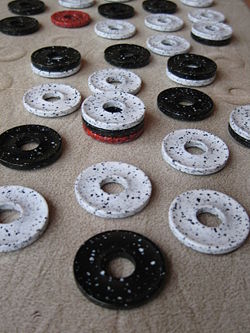- DVONN
-
DVONN 
Close-up board and game piecesDesigner(s) Kris Burm Publisher(s) Rio Grande Games
Don & Co.
SmartGamesPlayers 2 Age range 8 and up Setup time 0 minutes Playing time 30 minutes Random chance None Skill(s) required Strategic thought DVONN is a two-player strategy board game in which the objective is to accumulate pieces in stacks. It was released in 2001 by Kris Burm as the fourth game of the GIPF Project. DVONN won the 2002 International Gamers Award and the Games magazine Game of the Year Award in 2003.
Contents
Rules
Equipment
DVONN is played on a board with 49 spaces. The board has a hexagonal layout 5 hexes wide. One player has 23 black pieces to play, the other player has 23 white pieces. There are also 3 neutral red pieces, called DVONN pieces.
Object
The object of the game is to control more pieces than your opponent at the end of the game.
Placement phase
The game starts with an empty board, and proceeds in two phases. During the first phase the players place their pieces on the board, starting with the three red DVONN pieces. Pieces can be placed on any unoccupied space. White starts, and the players alternate. So Black is the first to place a piece of his own color. The first phase ends when all pieces are placed on the board, filling it completely.
Movement phase
The second phase involves the building of stacks of pieces (a single piece is also considered a stack) by moving stacks onto other stacks. A stack is controlled by a player if his color is on top. A stack is immobile if it is surrounded by 6 neighboring stacks. The white player has the first move in this phase. Any mobile stack of height n (with n > 0) can be moved (in a straight line) in any one of the 6 directions by exactly n spaces by the player controlling it, if it lands on another stack. Jumping over empty spaces is allowed, as long as the tower does not land on an empty space. Single DVONN pieces can not be moved, but they can be once they are part of a stack. After each move all stacks which are not connected via a chain of neighboring stacks to any stack containing a DVONN piece are removed from the board.
Passing and game end
A player who has no legal move must pass, and a player may only pass when no legal move is available. The game ends when both players have no legal moves. All stacks controlled by one player are collected into one tower. The winner is the player with the higher tower. The game ends in a draw in case both players own an equal number of stones in their tower. The maximum possible number of moves in the game is 97 (49 for placement and 48 in play, passes are not counted). In competition each player typically gets 15 minutes for the entire game in real-life tournaments, or 10 minutes for online tournaments.[1][2]
Strategy
The rules of DVONN can be learned in a few minutes. The main factor needed to win is to be in control of the game. The basic strategy of the game is given on the GIPF Project website.[3] The more advanced strategy tips are derived from the general strategy guidelines developed by the DVONN guild at the BrettspielWelt game site.[4] In 2003,[5] 2004,[6] and 2008 [7] the game developer, Kris Burm, organized a real life DVONN world championship.
Placement phase
Many beginner players place their pieces at the start of the game without a clear objective. However, placement is as major a factor in winning as the movement phase.
Pieces should be placed with three main goals in mind: spaces by DVONN pieces, spaces by the side, and general density. The first objective is to place pieces by DVONN pieces, thereby keeping them safe from potential separation. Keeping at least three pieces by each DVONN piece helps defend them from potential attack. Next, pieces that are surrounded cannot move; therefore, having pieces along the side to start the game is valuable. Such pieces should also be in position to free other pieces on the inside. Finally, lumping groups of one's own pieces together is usually poor strategy. It is desirable to capture on every move, or at least take a DVONN piece; keeping all of one's pieces together often makes this difficult. Spreading pieces out across the board also increases the chance of maintaining a short (and therefore highly mobile) stack into endgame, where it may be moved into position for a crucial capture.
It may also be possible to string a line of one's own pieces across the board up and down. Play almost always separates along this line; pieces on one side of a string that has no DVONN piece are usually doomed. An additional advantage of placing stones connected in a line is that moving a stone on either end of the line will free another own stone for movement.
Having an even distribution of the DVONN pieces over the board is usually recommended for novice players, since this way they will be less vulnerable against groups of stones being lost by a cut off. Having all 3 red Dvonn pieces grouped together near the edge almost guarantees a win for an experienced player playing with white.
As a remark about the setup phase it can be mentioned that it is not possible to guarantee victory with a strong setup, but it is possible to have no chance of winning by placing your stones badly.
Movement phase
The first few moves should correct any place where your position must be fixed: helping or moving pieces that could become isolated and moving outside pieces in order to give inside ones mobility. To go for a victory, one should try to recognize if it is possible to isolate part of the board from all the red DVONN pieces in such a way that the isolated part will contain more of the opponents stones that your own. Preferably, always play stones towards the DVONN pieces rather than away from them.
Capturing pieces that could capture a DVONN piece can be important, as a moving DVONN piece controlled by the opponent can isolate a large group of pieces. However, mobility is the most important aspect of DVONN; one needs to keep one's options open. Building a tall stack early in the movement phase is a mistake. Most often, the game is won by the player who is capable of making the last move(s). Maintaining some single stones until the end phase is, therefore, very often a good strategy. As a general rule one can state that using a tower to take a single stone of the opponent usually is one of the better moves, since this preserves own singles. A second general rule for selecting which move to make is that you should not make a move which the opponent cannot prevent you from making at a later time.
A very common mistake among beginners is that they are stacking own stones on top of each other in an attempt to prevent losing stones by being cut off by the opponent. However, since the game is all about mobility, this usually is a bad thing, since by stacking two of their own stones, instead of capturing an opponent's stone, they are effectively losing 2 stones. Only when a really large group of own stones is at risk, or in the end-phase of the game, one should consider placing own stones on top of each other. In any other situation, it is better to just give up the stone(s) in risk of being isolated and play offensive moves elsewhere and make the opponent lose a similar or preferably larger number of stones on another part of the board.
Taking a DVONN piece is especially desirable if it is possible to move it toward one's own pieces and away from one's opponent's. However, every capture counts, so big captures and maintaining mobility is more important than just taking DVONN pieces. A similar rule applies here as is the case for placing own stones on top of each other. When a DVONN piece is taken, the opponent is not losing a stone, which means that effectively you are set back 1 stone in the stonecount compared to the opponent. Therefore, one should only take a DVONN piece if one has a plan with it to gain a larger advantage, or if one needs to prevent the opponent from gaining a significant advantage by moving it.
After move 70 (about 20 moves into the movement phase) the board clears and settles. It becomes much more important to look ahead to see how every move affects the overall situation. Tall stacks are very hard to move, so they should be formed next to (or on) DVONN pieces and out of line of potential captures.
Strategy Terminology
DVONN strategy discussions among expert players often use a number of terms to express the game situation.[8] In the Yahoo Gipf discussion group the development of this list of terms was initiated by Alan Kwan and completed by Kris Burm.[9][10]
Dvonn playing computer programs
Currently four computer programs exist which play at a level very close to that of the best players. These programs are:
Both RoRoRo the Bot and Jan's program play online at the LittleGolem games site and are usually found to be among the top 10 players.[16]
See also
References
- ^ Burm, Kris. "World Championship 2004". http://www.gipf.com/dvonn/results/results_2004_WC07.html. Retrieved 2007-07-30.
- ^ "BrettspielWelt Dvonn guild forum". http://www.brettspielwelt.de/Forum/index.php?board=44.0. Retrieved 2007-07-30.
- ^ Burm, Kris. "Strategy". http://www.gipf.com/dvonn/strategy/strategy.html. Retrieved 2007-08-16.
- ^ Penelopé. "Leitfaden für Anfänger". http://www.brettspielwelt.de/Forum/index.php/topic,61318.0.html. Retrieved 2007-07-30.
- ^ Burm, Kris. "World Championship 2003". http://www.gipf.com/dvonn/results/results_2003_WC06.html. Retrieved 2007-07-30.
- ^ Burm, Kris. "World Championship 2004". http://www.gipf.com/dvonn/results/results_2004_WC07.html. Retrieved 2007-07-30.
- ^ Burm, Kris. "Dvonn World Championship at Mind Sports Olympiad 2008". http://www.deskohrani.cz/cgi/mso/index.pl?telo=vysledky.pl&turnaj=oly&jazyk=en&rok=2008&hra=dvo. Retrieved 2008-10-14.
- ^ "DVONN spelbeschrijving (with strategy terminology in English)". http://www.spelmagazijn.nl/nl/spelmag/dvonn.html. Retrieved 2007-07-31.
- ^ "GIPF · GIPF@egroups.com (unofficial GIPF mailing list)". http://games.groups.yahoo.com/group/GIPF/. Retrieved 2007-07-31.
- ^ Kwan, Alan. "DVONN: proposed glossary for strategy discussions". http://games.groups.yahoo.com/group/GIPF/message/191. Retrieved 2007-07-31.
- ^ NivoZero. "dDvonn". http://www.nivozero.com/DVONN/index.html. Retrieved 2007-10-02.
- ^ Bodenstein, Matthias. "Dvonner". http://matztias.de/spiele/dvonner/dvonner.htm. Retrieved 2007-10-02.
- ^ Carmody, Phil. "RoRoRo the Bot". http://www.littlegolem.net/jsp/info/player.jsp?plid=14203. Retrieved 2007-10-02.
- ^ de Graaf, Jan. "Jan's Program". http://www.littlegolem.net/jsp/info/player.jsp?plid=3107. Retrieved 2007-10-02.
- ^ de Graaf, Jan. "Dvonn practice program". http://www.littlegolem.net/jsp/forum/topic2.jsp?forum=30&topic=8. Retrieved 2007-10-02.
- ^ "Dvonn rating list". http://www.littlegolem.net/jsp/info/player_list.jsp?gtvar=dvonn_DEFAULT&countryid=&filter=&Send=submit. Retrieved 2007-10-02.
External links
- DVONN at BoardGameGeek
- Play DVONN online at Boardspace.net, against human or robot opponents.
Project GIPF Categories:- Abstract strategy games
- Mensa Select winners
- Kris Burm games
Wikimedia Foundation. 2010.

